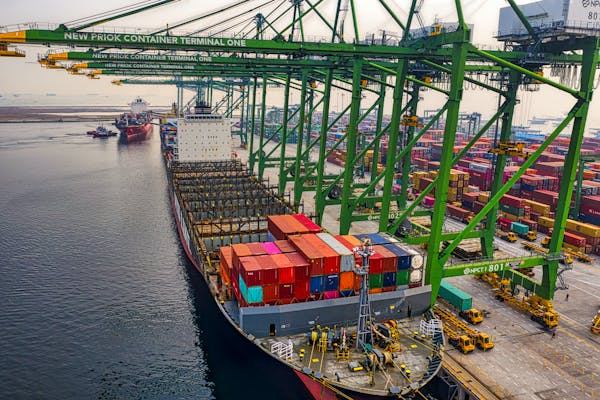Need to speed up your maritime hiring process while rapidly attracting top industry talent?
The maritime industry needs specialized solutions to manage its distinct recruiting challenges. The process of locating qualified crew members along with officers and shore staff continues to become more difficult as recruitment shortages plague the maritime sector.
The maritime industry is experiencing complete transformation because of new recruitment platforms. A suitable platform enables the transformation of your hiring process while also connecting you with qualified global candidates and establishing a dependable talent pipeline for your vessels and operations.
This article explains the key features which enable maritime recruitment platforms to perform effectively in the current competitive hiring environment.
What You’ll Discover:
- Why Maritime Recruitment Platforms Matter
- Must-Have Features for Effective Maritime Recruitment
- Measuring Success: KPIs for Maritime Recruitment
- Future Trends in Maritime Recruitment Technology
Why Maritime Recruitment Platforms Matter
The recruitment process for maritime positions stands apart from standard hiring practices across other sectors. The distinct blend of technical qualifications and certification requirements alongside necessary experience makes personnel recruitment complicated and lengthy.
The difficulty of this challenge has become more severe over the recent years. The Department of Defense reported that FY 2023 was the most difficult year for recruitment in the history of the All-Volunteer Force since its beginning because the Navy recruited only 30,236 sailors when it needed 37,700 according to DoD data.
What makes maritime recruitment even more challenging?
- Global workforce distribution
- Strict certification and qualification requirements
- High competition for experienced mariners
- Complex compliance regulations
- Extended time away from home

Specialized maritime recruitment platforms solve these specific industry challenges because they were built for that purpose. Using cloud-based crew control software from providers like Martide can dramatically transform your recruitment efficiency, providing specialized tools for finding, vetting, and hiring qualified maritime personnel.
Must-Have Features for Effective Maritime Recruitment
Different maritime recruitment platforms offer varying levels of effectiveness and functionality. The following essential features define what makes a maritime recruitment platform truly effective.
Comprehensive Candidate Database
The essential element of successful maritime recruitment platforms is a searchable database that contains qualified candidate profiles. This should include:
- Advanced filtering options for certifications and qualifications
- Detailed seafarer profiles with complete work history
- Document verification capabilities
- Searchable skill sets and specializations
- Multiple language support
This comprehensive approach helps overcome the recruitment challenges evidenced by the Navy’s FY 2024 targets: The Navy FY 2024 recruitment targets include 40,600 enlisted sailors and 2,807 active-duty officers alongside 7,629 enlisted reserve sailors and 1,785 reserve officers as reported here.
Automated Credential Verification
A primary time-intensive element in maritime recruitment involves checking candidates for their certifications and qualifications. Effective maritime recruitment platforms should offer:
- Automatic certificate expiration alerts
- STCW compliance checking
- Document authentication processes
- Integration with certification authorities
- Digital storage of all credentials
Customizable Application Process
Every maritime company has unique hiring requirements. The best platforms allow for:
- Custom application forms tailored to position types
- Adjustable screening questions
- Company-specific qualification requirements
- Branded application portals
- Mobile-friendly application processes
Intelligent Matching Algorithms
When vessel needs align perfectly with candidate skills companies save large amounts of time. Look for:
- AI-powered candidate matching
- Rank and vessel-type specific matching
- Availability-based recommendations
- Experience-weighted suggestions
- Skills gap analysis tools
Advanced matching features enabled the Navy to enhance its FY 2023 performance by signing 6,000 more future sailors than in FY 2022 which demonstrates successful pipeline recruitment strategies.
Crew Planning and Rotation Management
Successful maritime recruitment requires strategic planning beyond simple hiring processes. Great platforms include:
- Visual crew planning calendars
- Rotation schedule management
- Relief planning tools
- Contract end date alerts
- Integration with vessel schedules
Interview and Assessment Tools
Today’s maritime recruitment platforms need to use video interview features and skills assessments to make the screening process more efficient.
- Video interview capabilities
- Skills assessment modules
- Psychometric testing options
- Reference checking tools
- Standardized evaluation forms
Compliance and Reporting Features
Due to the diverse maritime regulations around the world, compliance management becomes essential.
- MLC 2006 compliance tracking
- Flag state requirement management
- Comprehensive reporting dashboards
- Audit-ready documentation
- Compliance risk alerts
Communication Hub
Global recruitment coordination relies upon strong communication practices.
- Centralized messaging system
- Automated notifications
- Multi-channel communication options
- Template-based messaging
- Communication tracking and history

Analytics and Reporting
Data-driven recruitment decisions lead to better outcomes:
- Recruitment funnel analytics
- Time-to-hire metrics
- Source effectiveness tracking
- Cost-per-hire calculations
- Custom report generation
The Bureau of Labor Statistics data from May 2023 shows that workforce distribution for Sailors and Marine Oilers varies by region which can help develop specific recruitment strategies per BLS findings.
Mobile Accessibility
The constant movement of maritime professionals requires immediate mobile access for effective communication and operations.
- Fully responsive design
- Native mobile applications
- Offline functionality
- Push notifications
- Simplified mobile interfaces
Measuring Success: KPIs for Maritime Recruitment
What indicators demonstrate that your maritime recruitment platform achieves its objectives? These key performance indicators will help you track the effectiveness of your maritime recruitment platform.
Time-to-Hire Metrics
- The typical time frame between posting a job listing and receiving an offer acceptance is measured by this metric.
- Time spent in each recruitment stage
- Comparison against industry benchmarks
Quality of Hire Indicators
- Performance ratings of new hires
- Retention rates by recruitment source
- Early termination percentages
- Promotion rates of new hires
Cost Efficiency Measures
- Total recruitment cost per position
- Platform ROI calculations
- Agency fee savings
- Staff time savings
Compliance Success Rate
- Percentage of fully compliant new hires
- Documentation completion rates
- Reduced compliance issues post-hire
The recent findings from the CPSC Drowning Report necessitate a more focused evaluation of recruitment effectiveness.
Future Trends in Maritime Recruitment Technology
The maritime recruitment landscape continues to evolve. Here are the emerging trends to watch:
AI and Predictive Analytics
- Candidate success prediction
- Retention risk forecasting
- Automated initial screening
- Pattern recognition in successful hires
Virtual Reality Assessments
- Simulated shipboard scenarios
- Technical skills testing in VR environments
- Emergency response evaluation
- Equipment operation assessment
Blockchain Credential Verification
- Immutable certification records
- Instant verification capabilities
- Reduced documentation fraud
- Streamlined credential transfers
Integrated Training Pathways
- Direct links to training providers
- Career development planning
- Skill gap remediation programs
- Continuous learning platforms
Wrapping It All Up
Today’s competitive hiring environment shows that maritime recruitment platforms have become essential tools for sourcing skilled personnel in a challenging job market. The Navy’s recruitment numbers for FY 2023 did not meet the target of 37,700 new recruits because only approximately 30,236 were enlisted which resulted in reaching just 80% of the target thereby showing the necessity for improved recruitment strategies.
The best maritime recruitment platform integrates advanced candidate management systems alongside task automation and compliance monitoring to empower data-driven hiring decisions that reshape your recruitment processes.
When evaluating platforms, focus on:
- The platform must be user-friendly and easily integrated across your organization.
- Scalability to grow with your fleet
- Integration capabilities with your existing systems
- Responsive customer support
- Continuous feature updates and improvements
The maritime sector faces distinct hiring challenges but the right recruitment technology helps construct a qualified crew pipeline essential for operational success even under tough hiring conditions.
Ready to transform your maritime recruitment process? The right platform is waiting.
